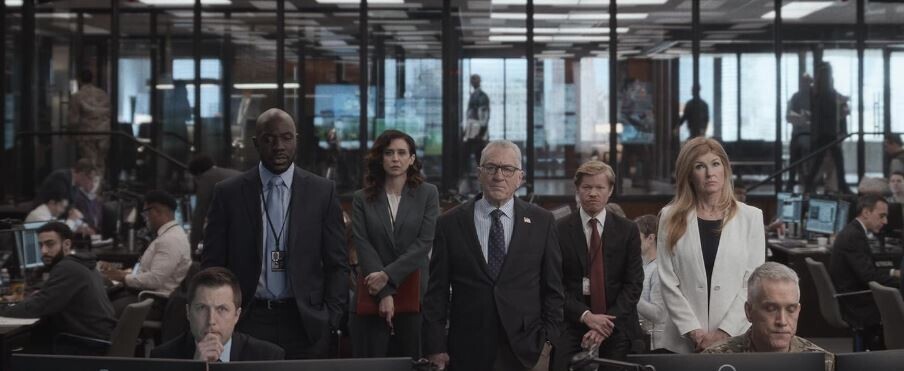 Netflix’s Zero Day, featuring the iconic Robert De Niro as George Mullen, dives into the thrilling yet terrifying realm of cyberattacks at a national level. The show walks viewers through a suspenseful plot, where Mullen, a former U.S. president, returns to the spotlight to tackle a devastating cyber catastrophe threatening the nation’s security. What’s more chilling is the concept of ‘Zero Day,’ which sounds like pure fiction but hits closer to home than you’d think.
Netflix’s Zero Day, featuring the iconic Robert De Niro as George Mullen, dives into the thrilling yet terrifying realm of cyberattacks at a national level. The show walks viewers through a suspenseful plot, where Mullen, a former U.S. president, returns to the spotlight to tackle a devastating cyber catastrophe threatening the nation’s security. What’s more chilling is the concept of ‘Zero Day,’ which sounds like pure fiction but hits closer to home than you’d think.
While the series is packed with drama, intrigues, and unexpected twists, it raises valid points about the nature of cyber threats today. In the real world, zero-day attacks are very much a genuine concern. The show highlights a fictional scenario, yet it gives a scary glimpse into how vulnerable our interconnected society can be if such an event were to occur.
In Zero Day, there’s dramatic tension as Mullen peels back layers of deception to find shocking truths about the perpetrators. This complexity of cyber warfare mirrors real-life situations where tracking down cybercriminals often involves navigating a web of disguises and deceit. In reality, disinformation campaigns like the ones in the show often accompany actual cyberattacks, muddling truth and spreading panic.
Sure, there’s a dash of Hollywood glam and suspense added for dramatic effect, making it a binge-worthy series. Yet, Zero Day taps into real anxieties about our digital future, questioning our preparedness for possible catastrophic events. It gets every viewer thinking: Could any of this actually happen?
The show sparked conversations about cybersecurity both in political spheres and casual discussions, bringing more awareness to a topic that’s usually tucked away in the tech quarters. Viewers, after watching the series, can’t help but grapple with the question of whether we are truly safe from such potential threats.
Zero Day, beyond its entertainment, prompts important reflections on our digital vulnerabilities. As a viewer and a citizen, it’s worth understanding the potential realities behind this thrilling narrative and what it teaches us about preparedness, trust, and truth in the digital age.
Understanding Zero Day Attacks
Zero day attacks aren’t just buzzwords; they’re a genuine headache for cybersecurity pros. So, what exactly are they? At their core, a zero day attack happens when hackers exploit a software vulnerability unknown to the software maker or user. Imagine breaking into a house through a door that nobody knew existed.
Historically, these attacks have created chaos and panic. Remember the infamous Stuxnet worm? It was one of the first known instances, showing the destructive potential of exploiting such vulnerabilities. These kinds of attacks often catch companies and governments off guard, allowing hackers to wreak havoc before anyone even notices what’s happening.
The thing about zero day vulnerabilities is their sneaky nature. Because they’re not known, they’re not patched. Hackers have free rein to deploy their exploits without immediate hurdles. Think of it like sneaking candy out of a jar when no one’s looking. But once the flaw is publicly disclosed and patching begins, it ceases to be a ‘zero day’ vulnerability.
Tactics used in these assaults vary, ranging from phishing to sophisticated malware deployment. Hackers are getting more creative, constantly improving their methods to stay a step ahead. And it’s not just big corporations on the chopping block; anyone connected to the internet could be susceptible, depending on the application’s vulnerability.
While zero day exploits differ from traditional cyberattacks due to their unseen nature, the fallout can be similarly destructive, if not more. The trickiest part? Defending against something you don’t know exists demands a proactive, almost foresight-like approach. Constant software updates, vigilance, and a solid security posture are essential to guard against these attacks.
The Realities of Zero Day in Today’s Digital World
Zero day attacks are much more than just tech paranoia; they’re very real threats that can affect anyone, from individuals to massive organizations. These unseen digital predators don’t discriminate, striking wherever vulnerabilities lie dormant.
Many industries today face the brunt of zero day exploits, with tech companies, financial institutions, and critical infrastructure often at the top of the target list. Imagine a city losing power because its grid’s software had an unknown flaw—sounds like a plot twist—but it’s a scenario that’s not too far-fetched.
Recent cases highlight the chaos these attacks can cause. One notable example is the Microsoft Exchange attack where multiple zero day vulnerabilities allowed hackers access to email servers worldwide. The fallout was swift, costly, and underscored how pervasive and damaging such breaches could be.
Bringing in the experts, cybersecurity gurus emphasize the importance of staying ahead of potential threats. They regularly share insights through reports and conferences, hammering home the critical need to update systems and educate users on safe practices. It’s like assembling a modern-day knight order—the armor is made of code and vigilance.
Organizations today are investing heavily in cycles of threat detection and response planning. These disruptions are reminders that preparing isn’t just optional—it’s necessary. Companies are doing everything they can to predict potential disruptions, build systems resilient enough to withstand them, and recover quickly if they are targeted.
It’s a digital age, and the truth is clear: zero day threats can pack a punch. Awareness and swift action are the keys to minimizing impact and ensuring that technology remains an asset rather than a liability.
 Can Fiction Become Reality? Exploring the Possibilities
Can Fiction Become Reality? Exploring the Possibilities
So, can the dramatic cyber nightmare of Netflix’s Zero Day actually leap off the screen and into real life? That’s a question boggling many minds after binging the show. Let’s crack open the possibilities.
Firstly, looking at expert opinions, most agree such massive attacks aren’t just the stuff of fiction. They could feasibly occur, especially with today’s sophisticated hacker collectives. While the sheer scope of Zero Day’s depicted attack might seem daunting, the foundation—exploiting unknown vulnerabilities—is a real and present threat.
Governments and organizations are on high alert, preparing for these scenarios. Crisis simulations and cyber drills are more commonplace now than ever before. These exercises are like fire drills but for your data, prepping teams for the potential shock of a large-scale digital invasion.
Now, if one did happen, the geopolitical and global impacts would be seismic. Countries could face disrupted economies, chaos in communications, and serious breaches of public trust—particularly if citizens’ personal data is compromised.
So, what’s the strategy? Steps to mitigate risks involve a mix of tech upgrades, employing skilled cybersecurity personnel, and creating foolproof recovery plans. It’s all about staying two steps ahead, like a high-stakes chess game with global ramifications. Adapting swiftly to emerging threats ensures that the nightmare of Zero Day remains on screen, not in reality.
Securing Our Digital Future: From Hollywood to Reality
Keeping our digital landscape safe is not just a sci-fi fantasy; it demands real-world action and awareness. While Zero Day the show offers a riveting storyline, our real-life script needs proactive cybersecurity strategies to match.
Individuals and countries can up their game with advanced cybersecurity measures. Think continuous software updates, employing encryption, and implementing multi-factor authentication. It’s about creating digital safety nets robust enough to fend off lurking threats.
Policies and regulations play a key role too. Initiatives aiming at tightening cybersecurity policies can guide both private and public sectors on safeguarding precious data. The more rules we follow, the fewer chances hackers have at finding loopholes.
As we’re eyeing the future, emerging tech trends bring newer vulnerabilities. But understanding and staying ahead of these potential risks is crucial. As AI, cloud computing, and the Internet of Things grow, so does our need for fortified cybersecurity.
An often-overlooked aspect is public awareness and education. By ramping up cybersecurity literacy—teaching everyday folks the basics of digital safety—we build a knowledgeable army ready to defend against cyber threats. Sometimes, a little awareness can go a long way in thwarting attacks.
Taking lessons from fictional worlds like Zero Day, our world can be a much safer place. It’s all a careful mix of preparation, response, and adaptation, ensuring our digital future is as secure as any good Hollywood ending would imply.
